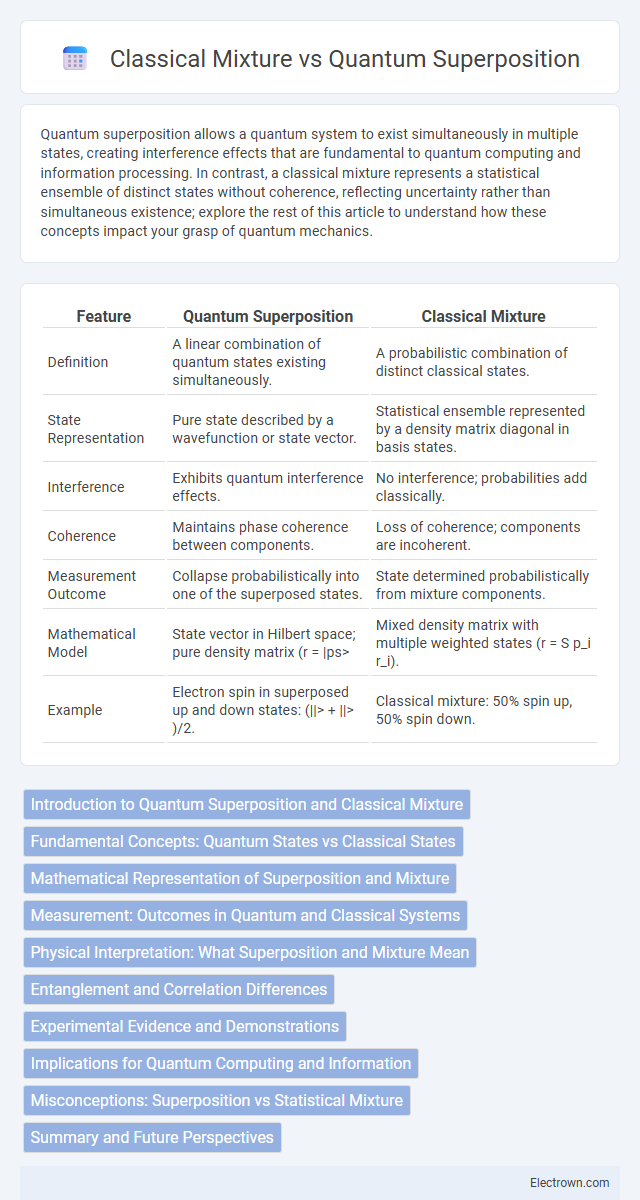Quantum superposition allows a quantum system to exist simultaneously in multiple states, creating interference effects that are fundamental to quantum computing and information processing. In contrast, a classical mixture represents a statistical ensemble of distinct states without coherence, reflecting uncertainty rather than simultaneous existence; explore the rest of this article to understand how these concepts impact your grasp of quantum mechanics.
Table of Comparison
| Feature | Quantum Superposition | Classical Mixture |
|---|---|---|
| Definition | A linear combination of quantum states existing simultaneously. | A probabilistic combination of distinct classical states. |
| State Representation | Pure state described by a wavefunction or state vector. | Statistical ensemble represented by a density matrix diagonal in basis states. |
| Interference | Exhibits quantum interference effects. | No interference; probabilities add classically. |
| Coherence | Maintains phase coherence between components. | Loss of coherence; components are incoherent. |
| Measurement Outcome | Collapse probabilistically into one of the superposed states. | State determined probabilistically from mixture components. |
| Mathematical Model | State vector in Hilbert space; pure density matrix (r = |ps> | Mixed density matrix with multiple weighted states (r = S p_i r_i). |
|
| Example | Electron spin in superposed up and down states: (||> + ||> )/2. | Classical mixture: 50% spin up, 50% spin down. |
Introduction to Quantum Superposition and Classical Mixture
Quantum superposition describes a fundamental principle where a quantum system exists simultaneously in multiple states until measured, represented by a coherent combination of state vectors in a Hilbert space. Classical mixtures, on the other hand, involve statistical ensembles of distinct states described by probability distributions without coherence, modeled as density matrices with diagonal elements only. Understanding the difference between quantum superposition and classical mixture is essential for interpreting phenomena in quantum computing, quantum information theory, and quantum measurement processes.
Fundamental Concepts: Quantum States vs Classical States
Quantum superposition describes a quantum state as a linear combination of basis states, enabling simultaneous existence in multiple states with complex probability amplitudes. Classical mixtures represent statistical ensembles where a system is in one definite state at a time, described by probability distributions without phase coherence. Unlike classical states, quantum states exhibit coherence and interference effects, fundamental to quantum information processing and entanglement phenomena.
Mathematical Representation of Superposition and Mixture
Quantum superposition is mathematically represented by a state vector |ps> in a Hilbert space, expressed as a linear combination of basis states with complex coefficients, reflecting coherent probability amplitudes. Classical mixtures are described by density matrices r, which represent statistical ensembles of states without coherence, as a probabilistic sum of projectors onto basis states. Unlike superpositions, mixtures lack interference terms, making their density matrix diagonal in the chosen basis, highlighting the fundamental difference in quantum versus classical description of states.
Measurement: Outcomes in Quantum and Classical Systems
Measurement outcomes in quantum superposition produce probabilistic results, with the quantum state collapsing into one of multiple possible eigenstates upon observation. In contrast, classical mixtures represent a statistical ensemble of definite states where measurement reveals a predetermined outcome without altering the system's state. Your understanding of these differences is crucial for interpreting quantum experiments and distinguishing quantum behavior from classical randomness.
Physical Interpretation: What Superposition and Mixture Mean
Quantum superposition represents a physical state where a quantum system simultaneously exists in multiple possible states, described by a single wavefunction with complex probability amplitudes that interfere coherently. Classical mixture refers to a statistical ensemble of distinct states with associated probabilities, described by a density matrix representing ignorance about the actual state without coherent interference. The physical interpretation distinguishes superposition by its coherence and phase relations enabling phenomena like interference, while mixtures imply a lack of quantum coherence and no such interference effects.
Entanglement and Correlation Differences
Quantum superposition exhibits entanglement where the overall quantum state cannot be separated into individual subsystems, resulting in correlations that are non-classical and stronger than classical mixtures. In contrast, classical mixtures represent statistical ensembles of distinct states without entanglement, producing correlations explainable by classical probability theory. These differences enable quantum systems to perform computational and communication tasks beyond classical capabilities through the exploitation of entanglement's unique correlation properties.
Experimental Evidence and Demonstrations
Experimental evidence distinguishing quantum superposition from classical mixture includes double-slit experiments, where interference patterns emerge only from coherent superpositions, not from classical statistical mixtures. Quantum state tomography provides detailed reconstructions of quantum states, revealing coherence and phase relations absent in classical mixtures. Your understanding of quantum phenomena relies on interpreting such experimental demonstrations that highlight non-classical behavior intrinsic to superposition.
Implications for Quantum Computing and Information
Quantum superposition enables qubits to exist in multiple states simultaneously, exponentially increasing computational power compared to classical bits that represent only definite states in a classical mixture. This fundamental property underpins quantum algorithms like Shor's and Grover's, offering superior efficiency for factoring and searching problems. Classical mixtures lack coherence and cannot exploit quantum entanglement, limiting their information processing capabilities in quantum computing architectures.
Misconceptions: Superposition vs Statistical Mixture
Quantum superposition represents a coherent combination of states allowing interference effects, whereas classical statistical mixtures describe probabilistic ensembles without phase coherence. Misconceptions arise when superposition is confused with classical mixtures, leading to incorrect interpretations of quantum behavior as merely probabilistic ignorance. Understanding the fundamental difference--superposition's inherent quantum coherence versus the lack of coherence in classical mixtures--is crucial for correctly interpreting quantum experiments and technologies.
Summary and Future Perspectives
Quantum superposition represents a fundamental principle where a quantum system simultaneously exists in multiple states until measured, contrasting with classical mixtures that describe probabilistic combinations of distinct states without coherence. Advances in quantum computing and quantum information theory continue to leverage superposition for enhanced processing power and secure communication. Future research aims to overcome decoherence challenges to fully exploit superposition in scalable quantum technologies and novel materials.
quantum superposition vs classical mixture Infographic

 electrown.com
electrown.com